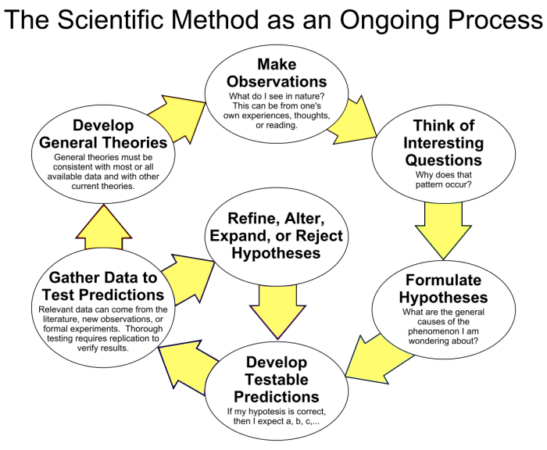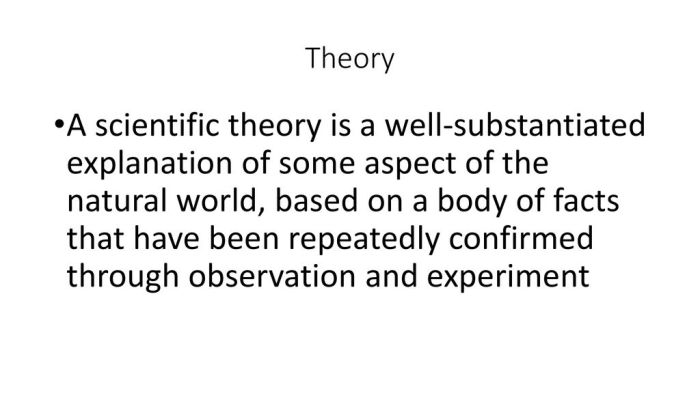
What is a law in science? This question delves into the heart of how we understand and explain the natural world. Scientific laws are not merely arbitrary rules but rather fundamental principles that describe the consistent and predictable patterns observed in nature. They are the bedrock of scientific understanding, providing a framework for predicting and explaining phenomena across various fields of study.
From the motion of celestial bodies to the chemical reactions that drive life, scientific laws offer a powerful lens through which we can unravel the mysteries of the universe. These laws are not static, however, but rather evolve as our understanding of the world deepens. Through rigorous experimentation, observation, and the constant pursuit of knowledge, scientists refine and expand our understanding of the fundamental laws that govern the natural world.
Laws of Nature vs. Laws of Science

The terms “laws of nature” and “laws of science” are often used interchangeably, but they represent distinct concepts. While both refer to fundamental principles governing the universe, their origins and interpretations differ.
Distinguishing Laws of Nature and Laws of Science, What is a law in science
Laws of nature are fundamental principles that describe the inherent order and behavior of the universe. They are considered universal and unchanging, independent of human observation or interpretation. These laws are often expressed as mathematical equations or concise statements, reflecting the underlying structure of the cosmos.
On the other hand, laws of science are human-constructed generalizations based on empirical observations and experimental evidence. They represent our current understanding of how natural phenomena occur, derived from meticulous scientific investigations. These laws are subject to refinement or even revision as new discoveries emerge, reflecting the evolving nature of scientific knowledge.
Examples of Laws of Nature and Laws of Science
Laws of Nature
- Law of Gravity: This fundamental law describes the attractive force between any two objects with mass. It is expressed mathematically as F = Gm1m2/r², where F is the force of gravity, G is the gravitational constant, m1 and m2 are the masses of the objects, and r is the distance between their centers.
- Conservation of Energy: This law states that energy cannot be created or destroyed, only transformed from one form to another. It is a fundamental principle governing all physical processes.
- Conservation of Momentum: This law states that the total momentum of a closed system remains constant. This principle is crucial for understanding the motion of objects in collisions and other interactions.
Laws of Science
- Newton’s Laws of Motion: These laws describe the relationship between force, mass, and acceleration. They form the foundation of classical mechanics and have been instrumental in understanding the motion of objects on Earth and in space.
- Boyle’s Law: This law describes the inverse relationship between the pressure and volume of a gas at constant temperature. It is a fundamental principle in chemistry and physics, used to understand the behavior of gases.
- Ohm’s Law: This law states that the current flowing through a conductor is directly proportional to the voltage applied across its ends and inversely proportional to the conductor’s resistance. It is a fundamental principle in electrical engineering, used to design and analyze electrical circuits.
The Role of Observation and Experimentation
Observation and experimentation are essential in formulating laws of science. Through careful observation, scientists identify patterns and regularities in natural phenomena. These observations are then tested through controlled experiments to verify their validity and establish causal relationships. The results of these experiments provide the foundation for constructing scientific laws, which are constantly refined and updated as new data emerges.
For example, the discovery of the law of gravity was based on careful observation of the motion of celestial bodies. Newton’s observations of the apple falling from the tree and the moon orbiting the Earth led him to propose the universal law of gravitation. This law was later tested and confirmed through numerous experiments, solidifying its status as a fundamental law of science.
Characteristics of Scientific Laws
Scientific laws are fundamental principles that describe the behavior of the natural world. They are based on empirical observations and repeated experiments, and they have been tested and verified over time. Unlike scientific theories, which offer explanations for phenomena, scientific laws describe how things work in the natural world.
Universality
Scientific laws are considered universal, meaning they apply across all space and time. They hold true regardless of location, time, or other conditions. This universality is a key characteristic that distinguishes scientific laws from other types of scientific knowledge.
- Newton’s Law of Universal Gravitation: This law states that every particle in the universe attracts every other particle with a force that is proportional to the product of their masses and inversely proportional to the square of the distance between their centers. This law applies to all objects in the universe, from planets to stars to atoms.
- The Law of Conservation of Energy: This law states that energy cannot be created or destroyed, only transformed from one form to another. This law applies to all physical processes, from the movement of planets to the chemical reactions that occur in living organisms.
Consistency
Scientific laws are consistent, meaning they hold true under the same conditions. They do not change with time or place, and they are not affected by external factors. This consistency is essential for the predictability and reliability of scientific laws.
- The Law of Conservation of Momentum: This law states that the total momentum of a closed system remains constant. This law applies to all collisions, from the impact of two cars to the collision of two atoms.
- The Law of Conservation of Mass: This law states that the total mass of a closed system remains constant. This law applies to all chemical reactions, from the burning of wood to the photosynthesis in plants.
Predictability
Scientific laws are predictable, meaning they can be used to predict future events. This predictability is based on the consistency and universality of scientific laws.
- Kepler’s Laws of Planetary Motion: These laws describe the motion of planets around the Sun. They can be used to predict the position of planets at any given time.
- Ohm’s Law: This law describes the relationship between voltage, current, and resistance in an electrical circuit. It can be used to predict the current flowing through a circuit given the voltage and resistance.
Types of Scientific Laws

Scientific laws are categorized based on the field of study they govern. While they share common characteristics, their specific applications and the phenomena they describe vary widely.
Physical Laws
Physical laws govern the behavior of matter and energy in the universe. They are fundamental principles that underpin our understanding of the physical world.
Physical laws are often expressed as mathematical equations, reflecting the precise and quantifiable nature of the phenomena they describe.
Examples of physical laws include:
- Newton’s Laws of Motion: These laws describe the relationship between force, mass, and acceleration. They form the foundation of classical mechanics and explain the motion of objects in our everyday experience.
- Law of Universal Gravitation: This law describes the attractive force between any two objects with mass. It explains why objects fall to the ground and how planets orbit the sun.
- Laws of Thermodynamics: These laws describe the relationship between heat, work, and energy. They govern the flow of energy in systems and are essential for understanding engines, refrigerators, and other technological processes.
Chemical Laws
Chemical laws govern the behavior of matter at the atomic and molecular level. They describe how atoms and molecules interact to form new substances.
Chemical laws are often expressed in terms of stoichiometry, the study of the quantitative relationships between reactants and products in chemical reactions.
Examples of chemical laws include:
- Law of Conservation of Mass: This law states that mass cannot be created or destroyed in ordinary chemical reactions. It explains why the total mass of reactants equals the total mass of products in a chemical reaction.
- Law of Definite Proportions: This law states that a given chemical compound always contains the same elements in the same proportions by mass. It explains why water always has a fixed ratio of hydrogen and oxygen atoms.
- Law of Multiple Proportions: This law states that when two elements combine to form more than one compound, the ratios of the masses of one element that combine with a fixed mass of the other element are simple whole numbers. This law helps to explain the existence of different compounds made from the same elements.
Biological Laws
Biological laws govern the behavior of living organisms. They describe the fundamental principles that underlie life processes, such as inheritance, evolution, and development.
Biological laws are often expressed in terms of probabilities, reflecting the inherent variability and complexity of living systems.
Examples of biological laws include:
- Mendel’s Laws of Inheritance: These laws describe the patterns of inheritance of traits from parents to offspring. They explain how genes are passed down through generations and how variations arise in populations.
- Hardy-Weinberg Principle: This principle describes the genetic makeup of a population that is not evolving. It provides a baseline for understanding how populations change over time due to factors such as natural selection, genetic drift, and gene flow.
- Central Dogma of Molecular Biology: This principle describes the flow of genetic information from DNA to RNA to protein. It explains how genes are expressed and how proteins are synthesized, which are essential for all life processes.
The Process of Developing Scientific Laws: What Is A Law In Science
Scientific laws are fundamental principles that describe the behavior of the natural world. They are based on repeated observations and experiments, and they are considered to be universally true and unchanging. The process of developing a scientific law is a rigorous and systematic one, involving several key steps.
This process is not linear; it is an iterative one where scientists constantly refine their understanding of the natural world. They often return to earlier steps in the process, gathering new data, revising their hypotheses, or conducting new experiments.
Hypothesis Testing
Hypothesis testing is a crucial step in the development of scientific laws. A hypothesis is a testable prediction about the relationship between two or more variables. Scientists use experiments to test their hypotheses and gather data. For example, a scientist might hypothesize that the rate of a chemical reaction is directly proportional to the concentration of the reactants. They would then design an experiment to test this hypothesis by varying the concentration of the reactants and measuring the rate of the reaction.
The results of the experiment will either support or refute the hypothesis. If the results support the hypothesis, the scientist may be able to formulate a more general statement about the relationship between the variables. However, if the results refute the hypothesis, the scientist must revise the hypothesis or develop a new one.
Data Analysis
Once data has been collected, scientists must analyze it to determine whether it supports or refutes their hypothesis. This process often involves using statistical methods to identify patterns and trends in the data. Data analysis can also help scientists to identify potential sources of error in their experiments.
For example, a scientist might use statistical analysis to determine whether there is a statistically significant difference in the rate of a chemical reaction at different temperatures. If there is a significant difference, the scientist can conclude that temperature affects the rate of the reaction. However, if there is no significant difference, the scientist must consider other factors that might be affecting the rate of the reaction.
Peer Review
Peer review is a process in which scientists submit their research findings to other scientists in their field for evaluation. Peer reviewers examine the research methods, data analysis, and conclusions of the study to ensure that they are sound and credible. This process helps to ensure that only high-quality research is published.
Peer review is a critical step in the development of scientific laws because it helps to identify errors and biases in research. It also helps to ensure that research findings are reproducible, which is essential for establishing the validity of a scientific law.
Reproducibility
Reproducibility is a key principle in scientific research. It means that the results of an experiment should be able to be replicated by other scientists using the same methods. Reproducibility is essential for establishing the validity of a scientific law.
If a scientific law is not reproducible, it is likely that there are errors in the research methods or data analysis. Reproducibility is also important for building confidence in scientific findings. If a scientific law can be reproduced by multiple scientists, it is more likely to be accurate and reliable.
Conclusive Thoughts

In conclusion, scientific laws are the cornerstones of our understanding of the natural world. They provide a framework for explaining phenomena, predicting outcomes, and driving technological advancements. While these laws are not absolute and may evolve as our knowledge expands, they remain a testament to the power of scientific inquiry and our relentless pursuit of understanding the universe around us. By embracing the principles of scientific laws, we unlock a deeper appreciation for the intricate and interconnected nature of the world we inhabit.
Answers to Common Questions
What is the difference between a law and a theory in science?
A scientific law describes a pattern or relationship that has been repeatedly observed and tested. A scientific theory is a well-substantiated explanation of some aspect of the natural world that can incorporate facts, laws, inferences, and tested hypotheses.
Are scientific laws absolute?
While scientific laws are generally considered to be reliable and universal, they can be modified or even overturned as new evidence emerges. Scientific knowledge is constantly evolving.
How do scientific laws contribute to technological advancements?
Scientific laws provide the foundation for understanding how things work. This understanding enables engineers and scientists to develop new technologies that leverage these principles for practical applications.




